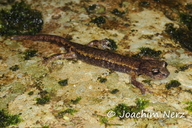|
Description
Total length of males up to 112 mm, for females up to 120 mm. Adult males have a
mental gland on the chin, which becomes more evident in mating season. Tail
oval in cross section and slightly less than half the total length. Trunk
on cross section square. Limbs well developed and hind legs slightly longer
than front legs. Front feet with 4, hind feet with 5 flattened digits.
Coloration as in other Hydromantes species highly variable, especially
in the northern populations. Base color from light brown to black. Venter
usually dark. Back often with spotted, blotched, striped or reticulated
pattern. Pattern may be in red, yellow, gray or green and these colors can
occur on the same animal, often with a metallic sheen. Different patterns can
occur together in the same population. The populations in the provinces
Bologna, Modena, Pistoia and Florence and southward usually have a typical
"italicus"-like coloration, consisting of red or yellow/ochre spots or
marbeled (Boehme et al 1999).
Distribution and Habitat
Country distribution from AmphibiaWeb's database: Italy, San Marino
H. italicus is a northern and central Alpinnine endemic, ranging from
the provinces of Reggio Emilia (Emillia-Romagna) and Lucca (Tuscany)
southwards to the province of Pescara inclusive (Abruzzi). Specimens from Pian di Mugnone, just N of Florence,
were introduced in 1983 naturalized in the cave "Buca del Nebbia".
11º14'11"E-43º20'09"N, 310m a.s.l., on the southern slope of Monte Maggio,
near Monteriggioni, province of Siena (Tuscany). The altitudinal distribution
ranges from 80 m a.s.l. in Garfagnana (near Anchiano, province of Lucca) up
to 1594 m on Mount Corchia (Apuan Alps, province of Lucca)
(Gasc 1997).
Life History, Abundance, Activity, and Special Behaviors
There is little data available on the reproduction of H. italicus in
its natural habitat. The following account on the life history of
H. italicus is derived from observations on H. ambrosii.
A clutch contains 6-14 eggs of 5-6 mm in diameter. The females seem to
keep in contact with their eggs. The eggs undergo direct development.
After 5 months, the egg starts to swell due to increased water uptake.
After 8 months, the egg has reached a diameter of 10mm. The egg then contracts
until hatching after 10 months (all at 12º C). The young are 22-24 mm in
length upon hatching. Development to sexual maturity takes 3 to 4 years.
Direct observation in captivity has shown that this species may live up
to six years. H. italicus seems to be an opportunistic hunter
with a wide range of invertebrate prey (Boehme et al 1999).
Trends and Threats
The Mediterranean region is subject to increasing human habitation causing
pollution, deforestation, fires, loss of surface waters and introduction of
exotic species. Despite these factors, H. italicus is not endangered.
This is mainly due to its relatively large distribution and its
water-independent biology (Boehme et al 1999). H. italicusi
is abundant in its range and should not be considered an endangered species.
It is, however, less abundant or even relatively uncommon only in the province
of Pescara, i.e. in the southernmost portion of its range (Gasc 1997).
Relation to Humans
Human activity has provided suitable habitats for this species in regions that
are not so naturally rich in caves as the Karst area. Exploitation of
"pietra serena" has yielded mounds of rocks near quarries and these and
the rock walls used in traditional agriculture are now inhabited by the
species.
Possible reasons for amphibian decline General habitat alteration and loss
References
Boehme, W., Grossenbacher, K., and Thiesmeier, B. (1999). Handbuch der Reptilien und Amphibien Europas, band 4/I:Schwanzlurche (Urodela). Aula-Verlag, Wiesbaden.
Gasc, J.-P. (1997). Atlas of Amphibians and Reptiles in Europe. Societas Europaea Herpetologica, Bonn, Germany.
Stumpel-Rieks, S. E. (1992). Nomina Herpetofaunae Europaeae. AULA-Verlag, Wiesbaden.
Originally submitted by: Arie van der Meijden (first posted 1999-10-21)
Edited by: David B. Wake (2021-01-26)Species Account Citation: AmphibiaWeb 2021 Hydromantes italicus: Italian Cave Salamander <https://amphibiaweb.org/species/4076> University of California, Berkeley, CA, USA. Accessed May 20, 2025.
Feedback or comments about this page.
Citation: AmphibiaWeb. 2025. <https://amphibiaweb.org> University of California, Berkeley, CA, USA. Accessed 20 May 2025.
AmphibiaWeb's policy on data use.
|




 Raffaëlli Account
Raffaëlli Account Map of Life
Map of Life